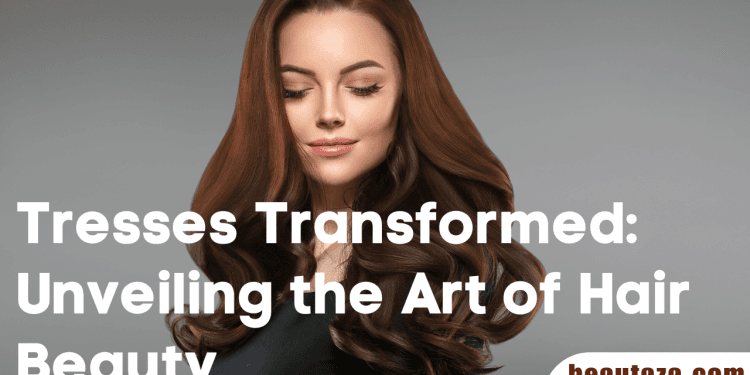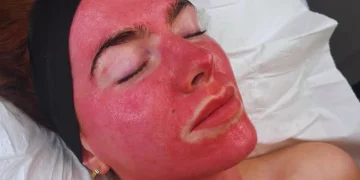
This article will examine the construction, variety, and maintenance of “hair tresses.” To help you always look your best, we’ll also provide some style and maintenance tips and techniques for your hair.
The Science of Hair Tresses
Long hair locks often connected to women’s hair are called hair tresses. Hair tresses may consist of blended, synthetic, or natural hair. Understanding the fundamental structure of hair is essential to comprehending hair tresses. The cuticle, cortex, and medulla are the three layers that makeup hair. The uppermost layer, the medulla, gives hair strength and suppleness. The pigment, which controls hair color and flexibility, is housed in the cortex, which surrounds the medulla.
The cuticle, the outermost covering, is a barrier to keep moisture and shield the plant from harm. To ease quantitative and qualitative investigations concerning shampoo, 120 medium-blond, fine Caucasian hair tresses were photographed, and the 1,080 photos were put into a database called the Figaro-tresses dataset. The dataset includes two categories of hair tresses: those that underwent controlled oxidative bleaching and those left in their natural form. The hair assembly characteristics in the dataset may be compared before and after cosmetic treatment.
Caring for Your Hair Tresses
Brushing and Combing
Comprehending the distinctions between brushing and combing hair and their recommended techniques is critical.
Using a proper brush will assist in detangling dry hair and distribute your scalp’s natural oils throughout your hair, nourishing the remaining portion of your hair. For dry hair, it is advised to use a brush with hardwood boar bristles since this helps to free the hair of debris and knots.
Use a detangling brush for wet hair or a wide-toothed comb to work through knots and tangles gently. It’s important to start at the tips and work your way up to the roots to minimize straining and breakage. Combing through knots from below instead of above is best to prevent pulling at the hair’s roots. It is advised to use a bamboo pick to untangle hair with curly hair, working your way up from the bottom.
Shampooing and Co-Washing
Two different approaches to cleaning and conditioning hair are shampooing and co-washing. Here is a contrast between the two:
Shampooing:
Involves washing the hair and scalp with a shampoo.
Usually carried out 1-2 times every week.
Sulfates, which may deplete hair from natural oils and irritate the scalp, are often included in shampoos.
Shampoos without sulfates are advised to reduce possible harm.
Co-washing:
Involves using conditioner rather than shampoo to wash hair.
Also referred to as washing just conditioner or not peeing.
May be advantageous for hair that is coiled, dry, or curly.
Because it might cause an accumulation of greasy residue, it is inappropriate for all hair types.
An alternate cleaning technique called co-washing substitutes conditioner for shampoo. Although it helps lessen breakage and aid with dry hair, it may also cause an accumulation of greasy residue. People may deal with this by periodically using a clarifying shampoo to remove buildup. Co-washing frequency is contingent upon the kind of hair; thicker hair is less likely to exhibit apparent oil accumulation than fine or thin hair.
Conditioning and Deep Conditioning
The health and vibrancy of hair depend on conditioning, especially deep conditioning.
Conditioning:
Usually carried out in the shower with a conditioning shampoo that is thinner.
After shampooing, it should be applied for less than five minutes to detangle, moisturize, and soften hair.
Strengthens and moisturizes the hair’s surface.
Ordinary conditioners aren’t designed to reach the core of the hair.
Deep Conditioning:
Meant to have a more pronounced and enduring impact, it may be used for ten to thirty minutes.
More nourishing than standard conditioners, it adds hydration and minimizes hair loss.
Trimming and Maintenance
Maintaining and trimming your hair tresses is crucial to keeping them looking their best. The following advice may help you maintain and cut your hair tresses:
Trimming:
Regular hair trimming helps to prevent split ends and preserve general health.
Take modest cuts at a time to prevent taking off too much length.
Wait until the hair is completely dry before cutting it to prevent needless hair loss.
Maintenance:
To protect your hair’s health, use shampoo and conditioner without sulfates.
To ensure lifespan, co-wash your hair tresses before installation.
Avoid using too many creams or oils on curly hair, which may lead to matting and tangling.
When hair is dried, avoid teasing it to prevent breaking.
Reduce your time using heat-styling appliances like curling irons, flat irons, and blow dryers since they may damage your hair and decrease its life.
Styling Tips for Hair Tresses
A creative and enjoyable method to showcase your individuality and sense of style is via hair styling. These are some style pointers for hair tresses:
Use hair care products made specifically for your hair type to keep your hair moisturized, clean, and groomed.
When you wash your hair the night before, the natural drying process reduces frizz and improves style.
To get the look you want, blow dry your hair using a blow dryer. Attach the Coanda smoothing drier to your towel-dried hair and let it air dry until 80% dry.
A more voluminous and textured appearance may be achieved by scrunching your hair.
Your hair may get additional depth and style by using rollers to help create curls and waves.
Wearing protective hairstyles helps your hair grow and maintain its length by shielding it from heat and harm.
Maintaining a healthy and moisturized appearance for curly hair types requires regular scalp and hair moisturizing.
To keep your hair healthy and knots-free, thoroughly condition it regularly.
Less is more in some situations. Choose hairstyles that need less manipulation and give your hair a rest in between protective styling to allow it to breathe.
Since your hair’s ends are the oldest, they are more likely to break and develop split ends. Care closely to these regions to guarantee hair development and a healthy appearance.
Conclusion
In summary, hair tresses are a chic and adaptable accessory that may improve how your hair looks. It’s important to understand their structure and acquire proper maintenance and styling techniques to ensure your hair tresses always look their best and last longer. You may create styles that fit your tastes and personal style by experimenting with various styling methods, deep conditioning, and product selection. There are many options for producing a distinctive and lovely hairdo, regardless of whether you choose natural, synthetic, or blended hair strands.













